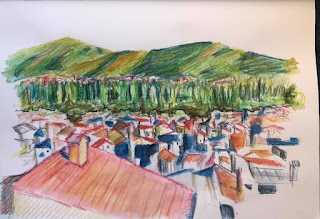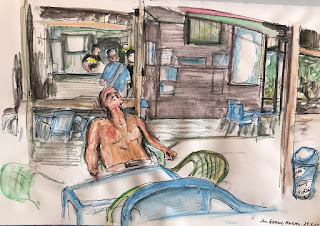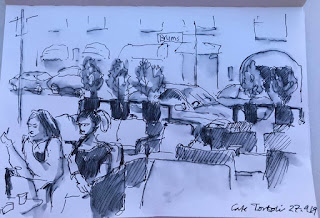We came to Kilkenny via Wales ready for Christmas. And we've visited Lamphey and Kells, two quite different church sites, both ruined, and different in so many ways, but provoking some ideas about how the rich spend their money and use their power.....
In Lamphey in Pembrokeshire you can visit the ruins of a once-gorgeous Bishop’s Palace. Created in the early 14th century by Henry de Gower (whose name indicates Norman origins nearly 300 years after the Conquest) who was Bishop at the cathedral of St David’s, not far away. Lamphey Palace or Court had rich and splendid buildings - a chapel and gatehouse of course, a wide perimeter wall, a huge barn for storing grain, and a hall with a truly show-off roof, having an arcaded parapet where guests could walk around and view the lovely valley. This parapet rising above the clerestory of arched windows lighting the hall beneath, is still there.
Across the water in Ireland we went to visit another ruined place, the Priory of Kells near Kilkenny. This is not the famous Kells Abbey, home of that radiant Book which now lives in the Library at Trinity College, Dublin, but an Augustinian house, built by Cornish monks in the twelfth century. Thus it predates Lamphey by about 140 years, and was not a pleasure palace but a monastery. The oddity of this place is its high standard of fortification. The founder was called Geoffrey Fitzrobert de Monte Marisco - whose name also reveals his aristocratic/Normal status - in fact he was an Anglo-Norman knight. There had been an earlier, pre-Norman church there, dedicated to an Irish saint, Kieran, but the new stone priory was dedicated to the Virgin Mary.
Here the remaining ruins look slightly less steady than those at Lamphey, and some are propped up with new buttresses, but they are utterly magnificent. There are many towers - clearly defensive. The nave, transept, cloister, the footings of many rooms and outbuildings all remain, like a labyrinth. The children running round with us stayed close, as it would be easy to get lost. At the back, there is of course a river racing through, known as the Kings River, and with an island and bridge - so here, too, there was a watermill. All these great houses had mills as a means of sustenance, and of taxation, as they could charge the peasants to grind their corn into flour. The ecclesiastical magnificence cannot be denied. It was a splendid place… and later attracted predatory attacks, because in due course the monks felt they had to build a huge curtain wall on the uphill side of their priory - with six towers complete with arrow slits and garderobes. Here they could graze their beasts more safely. And it made the whole place look like a military outpost rather than a house of prayer. Even today as you walk down from the road you see first of all this huge wall, with its spy-holes and slits, and you know the men inside were feeling defensive….
What struck me about these two ruined and more or less empty places was how expensive they were, how lavishly furnished according to their times, with carvings, huge windows, high walls and splendid adornments. Their builders - both scions of the Norman-French conquerors who in the turn of one single day in 1066 took the whole Anglo-Saxon kingdom (which I suppose then included Ireland) as their playground - used their power and wealth to build the pleasure-palace and the priory without a care in the world, or so it seems to me now. They chose plum sites, summoned their workforces, consulted the best architects, and set to work. Hundreds of years later we can admire what they did... how spectacularly they lived, how they could display all this to their friends. They lived like lords, which is what they were despite their church status.
And today, after the stunning victory of the bankers’ men in Westminster, and the alienation of so many people who fought for Britain to stay as part of Europe and for the real survival of our NHS, these two places have for me a sinister message. They show that the rich and mighty like to impose their wishes because they can, and their desire for comfortable survival over all the others, heedless of the pains of the poor, can all too easily be put into practice.





































